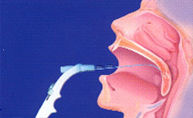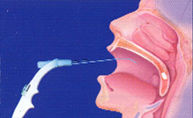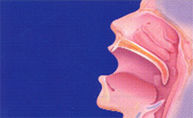Radiofrequency energy is sent below the surface of the soft palate.
A PAINLESS SOLUTION FOR SNORING AND NASAL OBSTRUCTION


The tissue is heated to a temperature that is sufficiently high to create a coagulation area.

After the following four to six weeks, the treated tissue will shrink and become stronger.
Tonsil reduction with radiofrequency treatment
RADIOFREQUENCY TREATMENT
What is radiofrequency treatment?
When is radiofrequency treatment used in ENT (otolaryngology)?
In ENT, radiofrequency treatment is prescribed for:
- Snoring in adults due to hypertrophy of the tonsils, palate, uvula and/or nasal turbinates. Snoring can be a sign of sleep apnoea, a serious condition characterised by pauses in breathing during sleep. The ENT (ear, nose and throat) specialist or otolaryngologist will need to perform a thorough examination to determine whether the patient is suffering from a respiratory disorder or just an ordinary case of snoring;
- Snoring in children due to hypertrophy of the tonsils. In some cases, the tonsils can be reduced with laser therapy (LINK TO LASER). The criteria for prescribing this treatment will depend on the consistency of the tonsil.
What does the treatment involve?
- For snoring in adults, the radiofrequency energy is directed at the mucous membrane, which is found beneath the surface of the target area (tonsils and/or soft palate and/or uvula and/or nasal turbinates). The target tissue is heated until an area of coagulation is formed. In the following weeks, the treated tissue falls away by itself, reducing the volume and strengthening the area causing the snoring;
- For chronic nasal obstruction due to hypertrophy of the nasal turbinates, the radiofrequency energy is directed below the surface of the turbinates. The tissue is heated to between 70ºC and 75ºC to create a zone of coagulation. In the following weeks the tissue reduces by itself;
- In these cases, the procedure is performed at our clinic under local anaesthetic, lasting less than 30 minutes;
- For laser-assisted tonsil reduction in children, the procedure is essentially the same;
- In the video below, Dr Jordi Coromina describes the treatment as it is being performed on the patient.
Advantages of radiofrequency treatment
- The radiofrequency procedure is painless. In fact, it is usually performed under local anaesthetic (except for tonsil reduction);
- One of the main advantages of this treatment is that there is no risk of haemorrhaging, which is a complication that arises in 6.7% of all tonsillectomies performed with the conventional technique;
- In tonsillar reduction, radiofrequency treatment allows a small portion of the tonsil tissue to be preserved, allowing the tonsils to continue performing their function: the production of antibodies;
- It can be performed on small children, even babies, as it is a painless and blood-free procedure;
- It only requires a hospital stay of several hours.